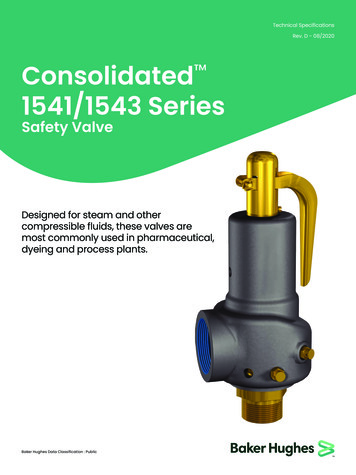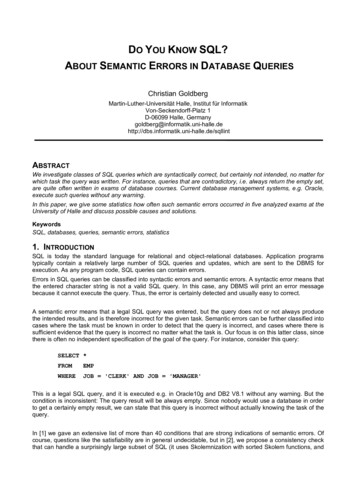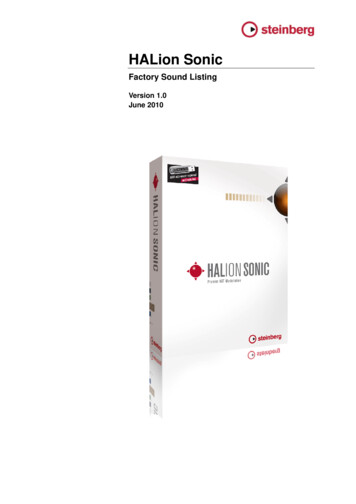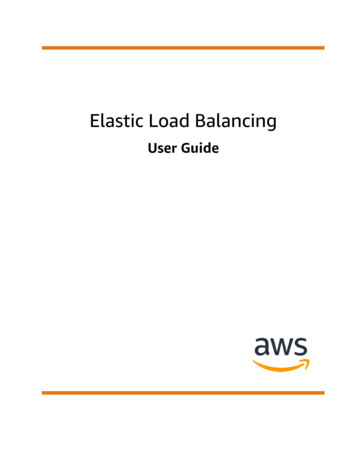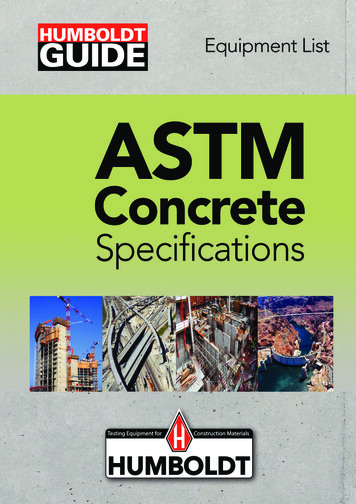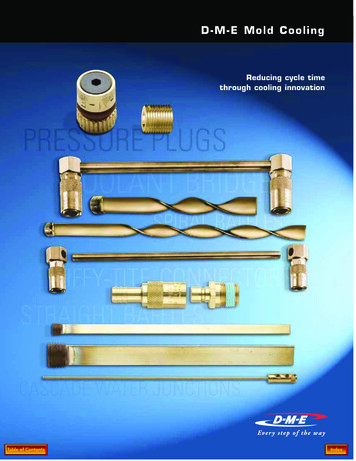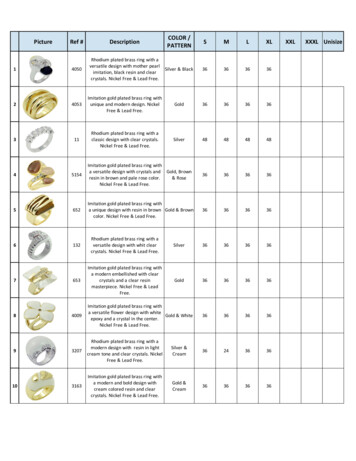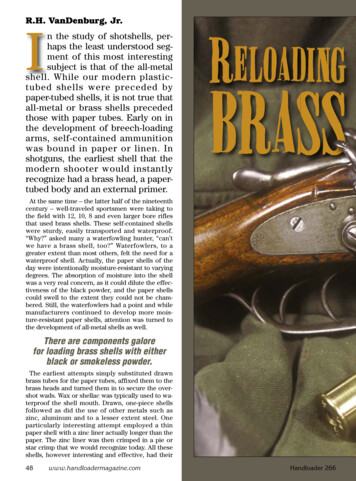
Transcription
R.H. VanDenburg, Jr.In the study of shotshells, perhaps the least understood segment of this most interestingsubject is that of the all-metalshell. While our modern plastictubed shells were preceded bypaper-tubed shells, it is not true thatall-metal or brass shells precededthose with paper tubes. Early on inthe development of breech-loadingarms, self-contained ammunitionwas bound in paper or linen. Inshotguns, the earliest shell that themodern shooter would instantlyrecognize had a brass head, a papertubed body and an external primer.RELOADINGBrassAt the same time – the latter half of the nineteenthcentury – well-traveled sportsmen were taking tothe field with 12, 10, 8 and even larger bore riflesthat used brass shells. These self-contained shellswere sturdy, easily transported and waterproof.“Why?” asked many a waterfowling hunter, “can’twe have a brass shell, too?” Waterfowlers, to agreater extent than most others, felt the need for awaterproof shell. Actually, the paper shells of theday were intentionally moisture-resistant to varyingdegrees. The absorption of moisture into the shellwas a very real concern, as it could dilute the effectiveness of the black powder, and the paper shellscould swell to the extent they could not be chambered. Still, the waterfowlers had a point and whilemanufacturers continued to develop more moisture-resistant paper shells, attention was turned tothe development of all-metal shells as well.There are components galorefor loading brass shells with eitherblack or smokeless powder.The earliest attempts simply substituted drawnbrass tubes for the paper tubes, affixed them to thebrass heads and turned them in to secure the overshot wads. Wax or shellac was typically used to waterproof the shell mouth. Drawn, one-piece shellsfollowed as did the use of other metals such aszinc, aluminum and to a lesser extent steel. Oneparticularly interesting attempt employed a thinpaper shell with a zinc liner actually longer than thepaper. The zinc liner was then crimped in a pie orstar crimp that we would recognize today. All theseshells, however interesting and effective, had their48www.handloadermagazine.comHandloader 266
PART I: Practical Tips for VersatilityShotshellsThis Model 1897 Bakerexternal hammer gun isfairly typical of its ilk.June-July 2010www.handloadermagazine.com49
RELOADINGBrass Shotshellsdrawbacks. The brass shells hada larger interior capacity thanpaper shells and required largerwads. True pie-crimping couldonly be accomplished by the ammunition factories, and the everincreasing cost of metals wouldeventually make the price prohibitive.The concept of the all-brassshell attracted the attention inEngland of Dr. Charles J. Heath,at one time president of theBritish Waterfowlers’ Association. Dr. Heath developed twoprecepts of shotgunning sciencethat, in differing forms, are stillwith us today. One was a “chamberless gun” that might bethought of as an early attempt atbackboring. Dr. Heath reasonedthat with the thin brass tubeshotshell there was no need forthe heavy forcing cone requiredof a gun shooting the papershells of the day and that it couldbe essentially removed and thebore enlarged to much the samesize as the interior of the brassshell. Of course, such a shellwould require much larger wadsand, for waterfowlers, hold moreHistoricalinformationregardingbrass shotshells isfound in avariety ofolder booksand catalogs.powder and shot. At the sametime such loads would not besuitable, perhaps even unsafe, foruse in a gun of standard dimensions. Few chamberless guns, asDr. Heath envisioned, were everbuilt.The second development of Dr.Heath was what today we thinkof as the “high density-low velocity” principle in which more andlarger shot were paired with alower-than-normal velocity for avery effective and useful load.In the 12-gauge, 2 1 2-inch brassOld published reports highlighted all-metal shells, this one from areprint of the “ALCAN Shotshell Reloader’s Manual, No. X” in the firstHandloader’s Digest.shells, Dr. Heath was able to pushas much as 2 ounces of BBs at800 fps with what he claimed tobe astonishing results.All the above, admittedly askimming of the highlights of theera, took place in England andEurope. In the U.S. similar activities flourished but with a decidedly American flavor.In the 1878 E. Remington & Sonscatalog of breechloading rifles,shotguns, pistols and ammunition, the company had this to say:“Of late years, the reloadingbrass shells for shotguns havecome much into use, and we recommend every sportsman tohave some of them on hand, asthey can always be loaded inplaces where it might be difficultto obtain paper shells. They arealso better at taking a larger wadin the same size chamber, andgiving more penetration, and areless liable to injury by wet. . . .We are prepared to furnish metalshells that we know are suitablefor our guns. They are made witha solid head, or flange, and fittedwith a steel cone, upon which theprimer is placed, and explodedby the firing-pin of the gun.These shells are put up in boxescontaining twenty-four shells,with primer extractor . . . for reHandloader 266
VICKERMANInline Seating DieGMW, Inc.Tel: 509-382-4159www.gmwvickerman.comQuality hand-cast bullets for reloaders,competitors & recreational shooters!Extensive selection of pistol, rifle,big bore & paper-patched bullets.Website: www.MontanaBulletWorks.com7730 Hesper Rd. Billings, MT 59106 Tel: 406-655-8163High PlainsAbove left, the CBC shell is drawn brass and accepts a large pistolprimer. Right, the RMC shell is turned from solid brass and cut for a209 battery cup primer.moving exploded caps; also inboxes containing ten shells, without extractor.”In comparing the above, in England and western Europe, shotshells were typically purchasedfrom an ammunition manufacturer or from one’s gunmaker. Inthe latter instance, the gunmakerpurchased empty shells, paper ormetal, and loaded them for hiscustomers, often to the customers’ specifications. In the lesssettled America, the need to beable to load, or reload, one’s ownshells far from any settlementwas of paramount concern.Fifty years later, in 1928, Maj.The RCBS Cowboy Shotshell Die setis designed to handle the CBC shells.Reboring & Barrels, L.L.C.Charles Askins, in his ModernShotguns and Loads, was ratherdismissive of both chamberlessguns and brass shells: “Whateverthe chamberless gun may or maynot do in the way of patterns, it isnot a practical arm. We are notgoing back to black powder norto brass cases, which must behand-loaded and carefully handled as was true fifty years ago.”In spite of such feelings, whichwere no doubt shared by many,the all-metal shell held on. In thefirst annual edition of Handloader’s Digest, edited by John T.Amber of Gun Digest fame andpublished in 1962, are depictedtools for loading brass shells. TheOffering Button andCut-Rifled Barrels.Most calibers and twist rates.Contact: Norman JohnsonPhone: 701-448-9188E-Mail: nrjonsn@westriv.com243 14th Avenue NW - Turtle Lake, ND 58575King Shooters Supply Inc.Roger’sBetter BulletsIF AT FIRST YOU DON’T SUCCEED. . . RELOAD 124 W. Church RoadKing of Prussia, PA 19406(610) 491-9901www.kingshooters.comHours:Tues - Fri: Noon to 9 p.m.Saturday: 9 a.m. to 5 p.m.FirearmsBuy Sell TradeClass 3 DealerBulletsRoger’s Better BulletsZero Frontier SierraHornady WinchesterReloadingJune-July 2010www.handloadermagazine.com51
RELOADINGBrass Shotshellsbook also contains the “ALCANShotshell Reloader’s Manual, No.X.” In it are several pages devoted to all-metal shells and thereloading of them. These includethe Alcan-Metal shotshell, whichwas a four-piece shell: a steelhead, aluminum tube, basewadand a metal overlay cup thatserved to reinforce the tube inthe powder area. Also listedwere a solid brass shell for usewith smokeless powder withRemington-type 57 primers and aBerdan-type solid shell for usewith black or smokeless powderand Berdan primers. Each wasavailable in gauges from 10 to.410, including 24 and 32 gauge.All-Metal shotshell reloading kitswere available in 12 gauge. In thebook’s section on Remingtoncomponents were listed all-brassThe C-H tool is a two-die set with a full-length sizing die and a seating/crimping die.shotshells in 12, 16, 20 and 28gauges and .410 bore. All but the.410 used No. 2 1 2 large pistolprimers. The .410 used No. 1 1 2small pistol primers. Our militaryused these in 12 gauge as guardshells with buckshot. Winchesterprovided a similar product.Tired of Run Out?Tired of Over Sizing?Want to ExtendBrass Life?The WTC Sizing Dieis the Answer to yourSizing Headaches!Minimal brass sizing for flawless chambering and maximum case life.Concentricities of .0005" or better from topto bottom.Head space adjustment within the die viahardened and ground tool steel retainerrings.Standard die body will accept die inserts forany caliber from 6mm to 30-06.Now introducing the Magnum die body thatwill accept larger cartridges up to 416 Rigby.2 part die insert construction - one for thebody, one for the neck and shoulder.Every die is custom made based on your fireformed brass.Wildcat Development and hydraulic formingservices available.201 Old Homestead Hwy. * N. Swanzey, NH * 03431603.352.9521 * Warner-tool.com52www.handloadermagazine.comAll well and good, you say, butsurely this is still the dim past.Not quite. Today there are atleast two sources of brass shotshells for U.S. reloaders and twosets of reloading dies. There alsoare components galore for loading brass shells with either blackor smokeless powder.The first all-brass shotshells areheadstamped “CBC (and thegauge)” and are manufactured byCompanhia Brazileira De Cartuchos in Brazil and imported intothe U.S. by MAGTECH Ammunition Co., Inc. of Minnesota (1800-466-7191). They are availablein 12, 16, 20 and 28 gauges and.410 bore. Other sizes are manufactured but may not be availablehere. These are drawn brass,one-piece shells with the primerpockets protruding into the shellinterior. Shell length is nominally21 2 inches. The 12-gauge shells onhand measure from 2.440 to 2.465inches. In type, they are very similar to the thin brass shells of Dr.Heath’s time and the Remingtonshells manufactured into the midtwentieth century. The primerpockets are, or were, sized forthe 6.45mm (#56 Tupan) primer.In the early years of their availability, we were informed to usesmall pistol primers. At sometime this changed, at least forthose shells imported into theU.S. Current CBC shells take aHandloader 266
RELOADINGBrass Shotshellslarge pistol primer. An attempt tolearn more about the change wasunsuccessful.The second all-brass shotshellis manufactured by Rocky Mountain Cartridge, LLC of Cody,Wyoming. These shells are turnedfrom solid brass and have thesame interior capacity and shapeas a typical straightwalled papershell. Primer pockets are cut forthe modern 209-style battery cupprimer. Dave Casey, proprietor,makes these shells to order, andgauge or bore and length are upto the customer. Casey will alsocut primer pockets to acceptlarge rifle primers, but he doesnot recommend it. Twelve-gaugeshells on hand are 2 5 8 inches(2.625 inches) in length. Headstamp is “RMC (and gauge).”When it comes to tools available to assist the reloader inloading brass shells, there aretwo. The first is from RCBS,called the Cowboy Shotshell Die,part number 99060, and is available only in 12 gauge. It consistsThe old LeeLoader kit forshotshells is idealfor reloadingbrass shells. TheDecapper &Base, right front,will removeprimers fromboth the RMCand CBC shells.of a simple aluminum die bodywith a screw-in steel sizing ring,a removable, steel decapping assembly, a crimping insert and asteel lock ring. The die comeswith a shellholder that fits anystandard metallic press ram. Thedie body is threaded 11 4x12 andwill fit most presses with a removable die bushing. This tool isdesigned to be used with theCBC shell and shot charges only.There is no seating stem for ballor bullet loading. Priming and depriming are done with the die seton one’s metallic press. Powder,wad and shot insertion are eitherdone by hand or on a shotshellreloading press or some combi-nation of both. If the brass shellis to be crimped, the CowboyShotshell Die is again employed.The second reloading tool isfrom C-H Tool & Die Company ofMt. Vernon, Ohio. This is an oldline reloading tool company nowunder the able direction of DaveDavidson. The C-H tool is available in most any gauge and shelllength. It is a two-die set, all steelwith aluminum locking rings.With 1 1 4x12 threads it too fitsmost any metallic press with a removable die bushing. Its shellholder fits standard reloadingtool rams. The first die is an inside-tapered, full-length sizing die– as opposed to RCBS’s sizingring. The second die is a seatingand crimp die. It includes an adjustable seating plug to hold theovershot wads, bullet or roundball securely positioned as theshell is crimped, much like amodern metallic seating/crimpingdie. Probably most C-H customers who purchase this die setare big-bore rifle shooters andtheir projectiles are roundballsrather than shot. The set willwork equally well with CBC orRMC shells, but depriming andrepriming of the latter must bedone elsewhere, as the standardmetallic presses will not accommodate 209 primers nor will thehole in the shellholder allowthem to be removed.Most who use brass shotshellswith shot loads will never have aneed to size the shells, but the54www.handloadermagazine.comHandloader 266
as a roll crimp, where the caseheight, something that might notuse of the shellholder whenmouth grips the bullet at the canexist with the CBC shells andworking with the CBC shells is anelure, in a crimping groove ormight be beyond the capabilitiesgreat help. Those who load bulletsometimes over the bullet ogive.of most case trimmers. Evenor ball will need the C-H toolIn some rimless handgun carmore important is a consistentboth for seating and crimping.tridges that headspace on thewad column height and a meansHere, sizing may become an issuecase mouth, a straight taperof keeping pressure on the overbut it is readily handled withcrimp is employed. In paper orshot wad as the crimp is beingthese fine dies. Whenever shellsare to be sized, they mustapplied. This is easily acfirst be lubed as is donecomplished with the C-HWhen it comes to tools availablewith metallic cases.tool with its seating plug.to assist the reloader in loading brass With the RCBS tool, aBefore we proceed, wedowel or something simshells, there are two.need to review some genilar must be insertederal topics in more deplastic shotshells, a roll crimp isthrough the top of the die andtail. The first is crimping. Bothone in which the shell mouth isheld in place against the overshottools allow for crimping. Theturned in 180 degrees to securewads as the ram is raised and theRCBS tool has a progressiveanovershotwad.Themorecomcrimp applied.crimp beginning at five degreesmonlyseenstarorpiecrimpisand progressing to 20 degrees.When a bulleted round isone in which the shell mouthThe C-H tool has a .175 inch racrimped, as the projectile leavesfolds inward to meet at the cendius crimp. Most crimp datathe case or shell, the crimp is auter obviating the need for anfound in old documents suggeststomatically removed. In a brassovershot wad. Neither of thesecrimps commonly ran from a .125shotshell, however, as the roundlatter two can be used with theradius to .175 inch. This all refersis fired, the overshot wad isbrass shells under discussion.to a turn in or slight roll crimp. Inforced out of the mouth of themetallic cartridges, a turning inTo properly crimp a brass shotshell and the shot follows, butshell calls for a consistent brasswithout exerting enough force onof the case mouth is referred toJune-July 2010www.handloadermagazine.com55
RELOADINGBrass Shotshellsthe crimp to remove it. Subsequent reloading of the shells isthen compromised as neither reloading tool has the ability to remove any leftover crimp.In an attempt to remove thecrimp, after trying this approachto loading brass shotshells, several methods were tried. A plumbbob, found at any hardwarestore, can be used. The ones I’veseen lately were chrome-platedsteel, were tapered and of a sizeto handle anything up to 12gauge. Ballistic Products, Inc. (1888-273-5623) makes tools for reshaping paper and plastic shells,but they are made of wood andunsuitable for this purpose. Anew hull conditioning tool calleda Spin Doctor is made of aluminum and showed some promise, but the brass shells scoredthe aluminum tool. It was designed to be used in a drill pressand still can be – just don’t turnon the press. A rawhide or plasticmallet, gently applied, is better.Perhaps better still would be tocut a short dowel to length anddrill a hole to accept the toolshank. Slide the dowel over theshank and tap the dowel with amallet. After numerous such attempts, the conclusion wasreached that if loading shot inbrass shotshells, it is best not tocrimp at all.Not only do we put less wearand tear on the shell mouths, butwad column height becomesunimportant. Adhesives ensurethat the overshot wads stay inplace in the field. In a range environment, a tight-fitting overshotwad may prove sufficient, butgluing in the overshot wads is amuch surer approach. I havecome to rely on two-part epoxy,applying it to the edge of firstone, then another, overshot wadof .025 or .030 inch. Each isseated separately. Epoxy canreadily be cleaned up with rubbing alcohol before it hardens.After firing, any residue insidethe shell can be removed with achamber brush or a brass brushof the next larger gauge. Othershave employed silicone adhesiveor simply a hot glue gun.A second subject is priming.Most of us first trying brass shotshells will not have access to either reloading tool. We’ll simplydo our reloading the old-fashioned way – by hand. Beginningwith a hard, flat surface, we placea primer, anvil up, position theshell over it and with a dowel inthe shell, tap the shell with a mallet until the primer is seated. Thisworks with either shell, but whenpriming the CBC shell, becausethe primer pocket protrudes intothe shell interior, the dowel mustbe drilled to accept the primer56www.handloadermagazine.comHandloader 266
The CBC shells can be primedand deprimed on most metallicpresses with a removablebushing. The dies are threaded11 4x12.pocket. A 5 16-inch hole is sufficient if properly centered. Depriming is another matter. A nailwith its point filed down hasbeen used for a century or more.Lee Precision sells a Decapper &Base in .22 and .30 caliber for depriming military cases withcrimped-in primers. The .22 caliber (Part No. 90103) is ideal fordecapping either of these shells.Reloaders with a metallic pressusing the CBC shell may opt topurchase one of the die sets (12gauge only from RCBS; anygauge from C-H) for on-presspriming and depriming. Thosewith a shotshell reloading pressof any gauge can use it for depriming and priming the RMCshell – just remove the sizing ringon the deprime station first, ifnecessary.Things can go wrong, however.Seating a large rifle primer in theCBC shell will result in a primerprotruding from the shell head.June-July 2010anyway (large rifle primers aretaller than large pistol primers)or to remove it can have a veryunpleasant result. Likewise,there are minor differences insome 209-type shotshell primerdiameters, and there is no “give”in the brass RMC shells.To effect the removal of the shellfrom the shellholder in such aneventuality is likely why theRCBS shellholder has a strategically placed trough cut in it. Aheavy-handed attempt to seat itThe moral of all this is that untilyou have perfected your primingand depriming procedures, workwith spent primers! With theRMC shells, even a dab of caselube on the outside of the batterycup at first would not be uncalled for.“Reloading Brass Shotshells”will be continued in HandloaderNo. 267 with loading proceduresand loads. www.handloadermagazine.com57
124 W. Church Road King of Prussia, PA 19406 (610) 491-9901 www.kingshooters.com Hours: Tues - Fri: Noon to 9 p.m. Saturday: 9 a.m. to 5 p.m. VICKERMAN Inline Seating Die GMW, Inc. Tel: 509-382-4159 www.gmwvickerman.com Quality hand-cast bullets for reloaders, competitors & recreational shooters! Extensive selection of pistol, rifle,

